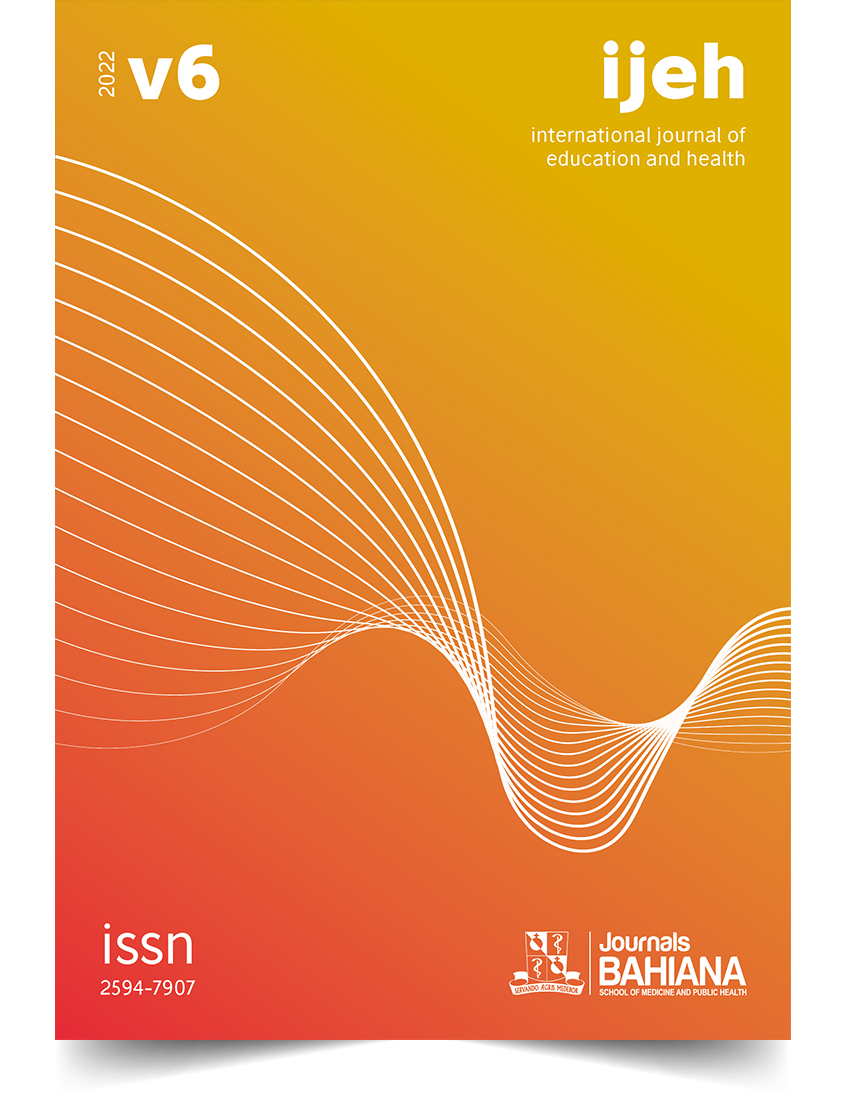Changes in the dynamics of an interest group in times of COVID-19: an experience report
DOI:
https://doi.org/10.17267/2594-7907ijeh.2022.e3857Keywords:
Education, Medical, Education, Distance, COVID-19, Interest groupsAbstract
INTRODUCTION: Complementary academical activities, such as Interest groups, are essential for the medical training. The SARS-CoV-2 pandemical context, however, imposed barriers in its functioning, and for the Pre-Hospital Emergencies Interest Group, it was no different. The achievement of the same goals during a scenario of abrupt virtualization of human relationships required innovative approaches that could optimize theoretical-practical and interpersonal learning. REPORT: The pre-pandemic context was based on face-to-face sessions, where knowledge was built through classes and courses given by the interest group members. The practical aspect was based on simulations and practical training, experiences that stimulated the integration between the students. However, the pandemic established the need to adapt the methodologies previously used. In the theoretical scope, video classes are made available for prior study, and then the contents of each are deepened in a virtual meeting, when students get to solve residency exam exercises and interactive clinical cases. Finally, to avoid losses in the integration between members, measures such as random divisions of subgroups for projects, as well as the habits of turning on webcams and providing constructive feedbacks about the performance of the members were instituted. DISCUSSION: The obstacles faced include the distance from interpersonal relationships and damage to the acquisition of teaching and practical skills, which are both fundamental to the medical experience. Despite these losses, medical education also obtained benefits, which are revealed by the greater flexibility of schedules, retention enhancing through review methods and knowledge increase by the discussion of scientific articles, in addition to the practice of giving and receiving constant feedback. Thus, ways to integrate these resources even after the pandemic is over have been discussed.
Downloads
References
Ministério da Educação (Brasil), Conselho Nacional de Educação, Câmara de Educação Superior. Resolução CNE/CES nº 4. Diretrizes Curriculares Nacionais do Curso de Graduação em Medicina [Internet]. Brasília: Ministério da Educação; 2001. Disponível em: http://portal.mec.gov.br/cne/arquivos/pdf/CES04.pdf
ABLAM (Brasil). Diretrizes Nacionais em Ligas Acadêmicas de Medicina [Internet]. Belo Horizonte: ABLAM; 2016. Disponível em: https://ablam.org.br/?page_id=153
Tavares AP, Ferreira RA, França EB, Fonseca Junior CA, Lopes GC, Dantas NGT, et al. O “Currículo Paralelo” dos Estudantes de Medicina da Universidade Federal de Minas Gerais. Revis Brasil de Educ Méd. 2007;31(3):254-65. https://doi.org/10.1590/S0100-55022007000300008
Presidência da República (Brasil). Constituição da República Federativa do Brasil de 1988. Brasília: Senado Federal; 1988.
Santana ACDA. Ligas acadêmicas estudantis. O médico e a realidade. Med (Rib Pret). 2012;45(1):96–8. https://doi.org/10.11606/issn.2176-7262.v45i1p96-98
Costa R, Lino MM, Souza AIJ, Lorenzini E, Fernandes GCM, Brehmer LCF, et al. Ensino de enfermagem em tempos de covid-19: como se reinventar nesse contexto? Text Context - enferm. 2020;29:2–4. https://doi.org/10.1590/1980-265X-TCE-2020-0002-0002
Belloni ML. Ensaio sobre a educação a distância no Brasil. Educ Soc. 2002;23(78):117–42. https://doi.org/10.1590/S0101-73302002000200008
Marchisotti GG, Oliveira FB, Lukosevicius AP. A representação social da educação a distância sob o olhar dos brasileiros. Ens: aval pol públ educ. 2017;25(96):743–69. https://doi.org/10.1590/S0104-40362017002500860
Lopes A. Zoom fatigue: o esgotamento provocado pelo excesso de videoconferências. Revista Veja. [Internet]. 2020 mai. 15 [citado em 2021 jan. 09] Disponível em: https://veja.abril.com.br/tecnologia/zoom-fatigue-o-esgotamento-provocado-pelo-excesso-de-videoconferencias/
Zuriarrain JM. Por que as videoconferências nos esgotam psicologicamente? Especialistas concluem que a ausência de contato físico exige mais atenção [Internet]. El País. 2020 mai. 06 [citado em 2021 jan. 6]. Disponível em: https://brasil.elpais.com/brasil/2020-05-06/por-que-as-videoconferencias-nos-esgotam-psicologicamente.html
Nicola JA, Paniz CM. A importância da utilização de diferentes recursos didáticos no Ensino de Ciências e Biologia. InFor [Internet]. 2017;2(1):355-81. Disponível em: https://ojs.ead.unesp.br/index.php/nead/article/view/InFor2120167
Rose S. Medical Student Education in the Time of COVID-19. Jama. 2020;323(21):2131–2132. https://doi.org/10.1001/jama.2020.5227
Carvalho AMP, Gonçalves MER. Formação continuada de professores: o vídeo como tecnologia facilitadora da reflexão. Cad. Pesqui. 2000;111:71-94. https://doi.org/10.1590/S0100-15742000000300004
Garcia MBO, Oliveira MM, Plantier AP. Interatividade e Mediação na Prática de Metodologia Ativa: o Uso da Instrução por Colegas e da Tecnologia na Educação Médica. Rev bras educ med. 2019;43(1):87-96. https://doi.org/10.1590/1981-52712015v43n1RB20180154
Silva WBH, Côrtes EMP, Marta CB, Francisco MTR, Silva PO, Santos RM, et al. Reinvenção das ligas acadêmicas em período de pandemia e interrupção das aulas presenciais. Glob Acad Nurs Journ. 2020;1(3):e51. https://doi.org/10.5935/2675-5602.20200051
Downloads
Published
Issue
Section
License
Copyright (c) 2022 Gabriela Malaquias Barreto Gomes, Ana Beatriz de Oliveira Andrade, Larissa Melo Targino, Fernando Muti Carvalho, Beatriz Silva Silveira, Epaminondas de Souza Mendes Junior

This work is licensed under a Creative Commons Attribution 4.0 International License.
This work is licensed under a Creative Commons Attribution 4.0 International License.



